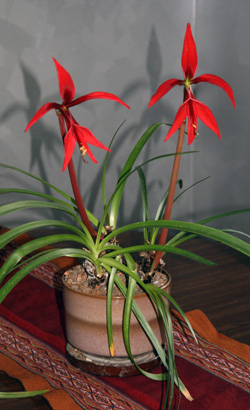
Aztec lily, or Jacobean lily, is one of just three known species of the genus Sprekelia in the amaryllis family (Amaryllidaceae). Sprekelia formosissima is the one usually grown for its showy flowers – and even it is not very common, especially in colder climates. This tender bulb, native to rocky hillsides of southern Mexico and Guatemala, is hardy only to zone 8 and higher. It is sometimes offered as Amaryllis formosissima. The genus is closely related to Hippeastrum, with which it may hybridize.
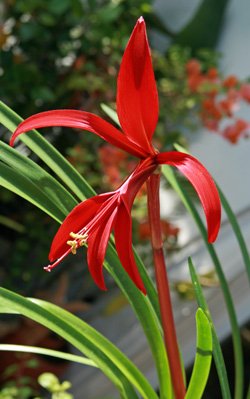
Unusual, brilliant red flowers up to 6″ across are borne singly on the end of sturdy, hollow, cylindrical scapes about a foot long. Each flower is bilaterally symmetrical, resembling a velvet orchid. They have six long tepals, with the broader, central upper one upright, two narrow lateral ones that are curved back at the tips and three lower narrow deflexed ones partly fused together, rolling up in a horizontal cylinder, encircling the long filaments of the stamens and large anthers with yellow pollen. Flower color is typically scarlet to deep crimson, but there are some pink selections, a white cultivar, and others that have lighter colored midribs or white edges on the red tepals. Unfortunately, the flowers only last for a few days, then quickly shrivel.
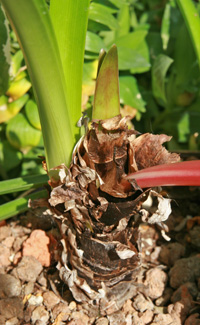
The long, dark-green, strap-like leaves emerge in spring about the same time as or before the flowers. In their native habitat, this is typically just after the first rains. They may bloom at other times of the year if grown in containers as a houseplant or in a greenhouse. If grown as a seasonal plant, they will bloom later, often several weeks after planting out. Several leaves are produced from each bulb, growing in an upright rosette at first, then flopping over as they get longer. The bulbs may be up to 2″ in diameter.
The species does not consistently flower every year, but some selections or hybrids are much more reliable bloomers. Each bulb may produce more than one flower stalk annually, but in usually sequence and not at the same time. Some selections will bloom in both spring and fall. The cultivar ‘Orient Red’ (also called ‘Harrison’s Orientred’) is much more robust than the species and will produce several flushes of flowers throughout the growing season. xHippeastrelia is a hybrid between Hippeastrum and Sprekelia.
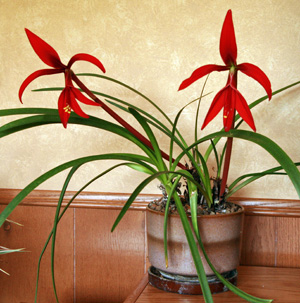
In mild climates, this herbaceous perennial bulb is grown in well-drained soil and mulched for the winter. In the Midwest, Aztec lily can be planted in the ground during the growing season, but it may be easier to grow as a container plant. If growing in-ground, wait until the soil has warmed and all danger of frost is past to plant the bulbs in free-draining soil, such as in a rock garden. Excessive soil moisture may cause the bulbs to rot or not flower. The bulbs must be dug up in the fall, and then stored in a dry, frost-free location for the winter. However, this plant resents being disturbed and may not flower for several years after being dug or divided.
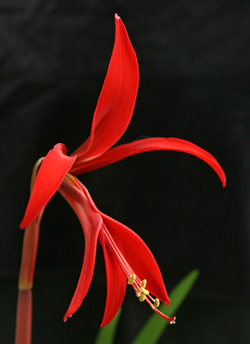
Growing in containers – using a well-drained potting mix – makes it easy to move the plants for protection from cold or too much rainfall, and the bulbs can remain undisturbed in their pot for 3-4 years. The entire container can be moved indoors for the winter, or kept as a houseplant year-round as long as it receives at least 4 hours of sunlight a day. When the leaves begin to die back it should not be watered and should remain dry while dormant. Watering should resume once new growth begins to show and during flowering.
Aztec lily needs full sun to thrive, although they will tolerate partial shade in hot climates. When planting bulbs in the ground, space them 8-12″ apart and 4″ deep, leaving the neck of the bulb just above the soil level. In containers, use a 6″ container for each bulb, or place several in larger containers, about 4″ apart. Fertilize container-grown bulbs lightly only when growing. Aztec lily has few pests but may become infested with mealybugs which hide in the crevices where the leaves emerge from the bulb.
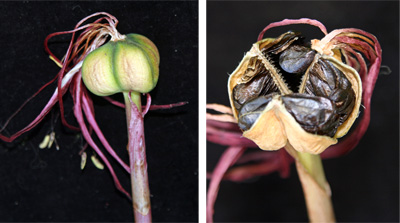
Aztec lily does produce seed (requiring pollination from a different clone to produce viable seed), but is more rapidly propagated by removing the readily produced offset bulblets from the parent plant. The bulbs should be dug and separated in late summer or early fall when dormant, replanting the parents and offspring separately. If flowers are pollinated and set seed, the fruit capsule should be allowed to mature on the plant and the flat, black winged seeds harvested when the 3-valved pod splits open. Sow fresh seed in well-drained potting medium and keep moist until germinated. Young plants should be maintained without winter dormancy for the first two years and then can be treated like mature plants. Plants grown from seed may take up to 7 years to flower
– Susan Mahr, University of Wisconsin – Madison
Latest from Wisconsin Yard & Garden
Ask Your Gardening Question
If you’re unable to find the information you need, please submit your gardening question here:





 Marigolds
Marigolds Create a Butterfly Garden
Create a Butterfly Garden Plant Flowers to Encourage Beneficial Insects
Plant Flowers to Encourage Beneficial Insects Forcing Bulbs
Forcing Bulbs


